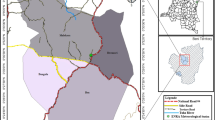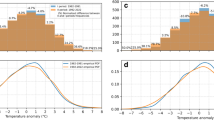Abstract
Based on daily maximum and minimum temperature observed by the China Meteorological Administration at 115 meteorological stations in the Yangtze River Basin from 1962 to 2011, the methods of linear regression, principal component analysis and correlation analysis are employed to investigate the temporal variability and spatial distribution of temperature extremes. Sixteen indices of extreme temperature are selected. The results are as follows: (1) The occurrence of cold days, cold nights, ice days, frost days and cold spell duration indicator has significantly decreased by −0.84, −2.78, −0.48, −3.29 and −0.67 days per decade, respectively. While the occurrence of warm days, warm nights, summer days, tropical nights, warm spell duration indicator and growing season length shows statistically significant increasing trends at rates of 2.24, 2.86, 2.93, 1.80, 0.83 and 2.30 days per decade, respectively. The tendency rate of the coldest day, coldest night, warmest day, warmest night and diurnal temperature range is 0.33, 0.47, 0.16, 0.19 and −0.07°C per decade, respectively. (2) The magnitudes of changes in cold indices (cold nights, coldest day and coldest night) are obviously greater than those of warm indices (warm nights, warmest day and warmest night). The change ranges of night indices (warm nights and cold nights) are larger than those of day indices (warm days and cold days), which indicates that the change of day and night temperature is asymmetrical. (3) Spatially, the regionally averaged values of cold indices in the upper reaches of the Yangtze River Basin are larger than those in the middle and lower reaches. However, the regionally averaged values of most warm indices (except warm spell duration indicator) and growing season length in the middle and lower reaches are larger than those in the upper reaches. (4) The extreme temperature indices are well correlated with each other except diurnal temperature range.
Similar content being viewed by others
References
Aguilar E, Barry A, Brunet M et al., 2009. Changes in temperature and precipitation extremes in western Central Africa, Guinea Conakry, and Zimbabwe, 1955–2006. Journal of Geophysical Research, 114, D02115, doi: 10.1029/2008JD011010.
Aguilar E, Peterson T C, Obando P R et al., 2005. Changes in precipitation and temperature extremes in Central America and northern South America, 1961–2003. Journal of Geophysical Research, 110, D23107, doi: 10.1029/2005JD006119.
Alexander L V, Zhang X, Peterson T C et al., 2006. Global observed changes in daily climate extremes of temperature and precipitation. Journal of Geophysical Research, 111, D05109, doi: 10.1029/2005JD006290.
Changnon S A, Pielke Jr R A, Changnon D et al., 2000. Human factors explain the increased losses from weather and climate extremes. Bulletin of American Meteorological Society, 81: 437–442.
Cheng Xiaoguang, Declan C, Zheng Guangfen et al., 2008. Trends of extreme temperature in Ningxia during 1961–2004. Advances in Climate Change Research, 4(2): 73–77. (in Chinese)
Choi G, Collins D, Ren G Y et al., 2009. Changes in means and extreme events of temperature and precipitation in the Asia-Pacific Network region, 1955–2007. International Journal of Climatology, 29: 1906–1925.
Ding Bin, Gu Xianyue, Liao Qilong, 2006. Characteristics in the variation of temperature over the Yangtze River valley over last 50 years. Resources and Environment in the Yangtze Basin, 15(4): 531–536. (in Chinese)
Ding Yihui, Ren Guoyu, Shi Guangyu et al., 2006. National Assessment Report of Climate Change (I): Climate change in China and its future trend. Advances in Climate Change Research, 2(1): 3–8. (in Chinese)
Easterling D R, Evans J L, Grolsman P Ya et al., 2000. Observed variability and trends in extreme climate events: A brief review. Bulletin of American Meteorological Society, 81(3): 417–425.
Editorial Committee of China’s National Assessment Report (ECCNAR) on Climate Change, 2007. The China’s National Assessment Report on Climate Change. Beijing: Science Press, 18–40. (in Chinese)
Frich P, 1999. REWARD: A Nordic Collaborative Project. Annex of “Meeting of the Joint CCl/CLIVAR Task Group on Climate Indices, Bracknell, UK, 2–4 September 1998//Folland C K, Horton E B, Scholefield P R. World Climate Data and Monitoring Programme, WCDMP-No.37, WMO-TD No.930. Geneva: World Meteorological Organization.
Gao Huixuan, 2005. Application of Multivariate Statistical Analysis. Beijing: Peking University Press, 1–213. (in Chinese)
Gong Daoyi, Han Hui, 2004. Extreme climate events in northern China over the last 50 years. Acta Geographica Sinica, 59(2): 230–238. (in Chinese)
Griffiths G M, Chambers L E, Haylock M R et al., 2005. Change in mean temperature as a predictor of extreme temperature change in the Asia-Pacific region. International Journal of Climatology, 25(10): 1301–1330.
Gruza G, Rankova E, Razuvaev V et al., 1999. Indicators of climate change for the Russian Federation. Climatic Change, 42(1): 219–242.
IPCC, 2007. Summary for Policymakers of Climate Change 2007: The Physical Science Basis. Contribution of Working Group I to the Fourth Assessment Report of the Intergovernmental Panel on Climate Change, Cambridge, UK: Cambridge University Press.
Jones P D, Horton E B, Folland C K et al., 1999. The use of indices to identify changes in climatic extremes. Climatic Change, 42(1): 131–149.
Klein A M G, Konnen, G P, 2003. Trends in indices of daily temperature and precipitation extremes in Europe, 1946–99. Journal of Climate, 16(22): 3665–3680.
Klein Tank A M G, Peterson T C, Quadir D A et al., 2006. Changes in daily temperature and precipitation extremes in Central and South Asia. Journal of Geophysical Research, 111, D16105, doi: 10.1029/2005JD006316.
Li Lingping, Xue Xinling, Li Yanying et al., 2010. Changes in the extreme temperatures in the east of Hexi Corridor in 1961–2005. Journal of Glaciology and Geocryology, 32(1): 43–51. (in Chinese)
Li Z X, He Y Q, Wang P Y et al., 2012a. Changes of daily climate extremes in southwestern China during 1961–2008. Global and Planetary Change, 80/81: 255–272.
Li Z X, He Y Q, Wilfred H T et al., 2012b. Altitude dependency of trends of daily climate extremes in southwestern China, 1961–2008. Journal of Geographical Sciences, 22(3): 416–430.
Liu Xiaoling, Yin Shuyan, Wang Hanyan, 2011. Analysis on extreme temperature events during 1951–2009 in Xi’an. Journal of Arid Land Resources and Environment, 25(5): 113–116. (in Chinese)
New M, Hewitson B, Stephenson D B et al., 2006. Evidence of trends in daily climate extremes over southern and west Africa. Journal of Geophysical Research Atmospheres, 111, D14102, doi: 10.1029/2005JD006289.
Pepin N C, Seidel D J, 2005. A global comparison of surface and free-air temperatures at high elevations. Journal of Geophysical Research, 110, D03104, doi: 10.1029/2004JD005047.
Peterson T C, Taylor M A, Demeritte R et al., 2002. Recent changes in climate extremes in the Caribbean region. Journal of Geophysical Research, 107(D21), 4601, doi: 10.1029/2002JD002251.
Qian K Z, Wan L, Wang X S et al., 2012. Periodical characteristics of baseflow in the source region of the Yangtze River. Journal of Arid Land, 4(2): 113–122.
Su B D, Jiang T, Jin W B, 2006. Recent trends in observed temperature and precipitation extremes in the Yangtze River Basin, China. Theoretical and Applied Climatology, 83(1–4): 139–151.
Su B D, Xiao B, Zhu D M et al., 2005. Trends in frequency of precipitation extremes in the Yangtze River Basin, China: 1960–2003. Hydrological Sciences Journal, 50(3): 479–492.
Suh M S, Lee D K, 2004. Impacts of land use/cover changes on surface climate over East Asia for extreme climate cases using RegCM2. Journal of Geophysical Research, 109, D02108, doi: 10.1029/2003JD003681.
Sun Jialan, Lei Xiaohui, Jiang Yunzhong et al., 2012. Variation trend analysis of meteorological variables and runoff in upper reaches of Yangtze River. Water Resources and Power, 30(5): 1–4. (in Chinese)
Vincent L A, Peterson T C, Barros V R et al., 2005. Observed trends in indices of daily temperature extremes in South American1960–2000. Journal of Climate, 18: 5011–5023.
Wang B L, Zhang M J, Wei J L et al., 2012. Change in extreme events of temperature and precipitation over Xinjiang, Northwest China, during 1960–2009. Quaternary International, doi: 10.1016/j.quaint.2012.09.010.
Wang Baolong, Zhang Mingjun, Wei Junling et al., 2012. The change in extreme events of temperature and precipitation over Northwest China in recent 50 years. Journal of Natural Resources, 27(10): 1720–1733. (in Chinese)
Wang Yanjun, Liu Bo, Zhai Jianqing et al., 2011. Relationship between potential and actual evaporation in Yangtze River Basin. Advances in Climate Change Research, 7(6): 1673–1719. (in Chinese)
Wu L Y, Zhang J Y, Dong W J, 2011. Vegetation effects on mean daily maximum and minimum surface air temperatures over China. Chinese Science Bulletin, 56(9): 900–905.
You Q L, Kang S C, Aguilar E et al., 2008. Changes in daily climate extremes in the eastern and central Tibetan Plateau during 1961–2005. Journal of Geophysical Research Atmospheres, 113, D07101, doi: 10.1029/2007JD009389.
You Q L, Kang S C, Aguilar E et al., 2011. Changes in daily climate extremes in China and their connection to the large scale atmospheric circulation during 1961–2003. Climate Dynamics, 36(11/12): 2399–2417.
Zhai Panmao, Pan Xiaohua, 2003. Change in extreme temperature and precipitation over northern China during the second half of the 20th century. Acta Geographica Sinica, 58(suppl.): 1–9. (in Chinese)
Zhang Yaoting, 2003. Lecture Notes of Multiple Statistical Analysis. Beijing: China Statistics Press, 1–144. (in Chinese)
Zhao M, Pitman A J, 2002. The impact of land covers change and increasing carbon dioxide on the extreme and frequency of maximum temperature and convective precipitation. Geophysical Research Letters, 29(6), doi: 10.1029/2001GL013476.
Zhou Yaqing, Ren Guoyu, 2010. Variation characteristics of extreme temperature indices in mainland China during 1956–2008. Climatic and Environmental Research, 15(4): 405–417. (in Chinese)
Author information
Authors and Affiliations
Corresponding author
Additional information
Foundation: National Basic Research Program of China (973 Program), No.2013CBA01801; National Natural Science Foundation of China, No.41161012, No.41240001; Basic Scientific Research Foundation in University of Gansu Province
Author: Wang Qiong (1987–), MS Candidate, specialized in global change and sustainable development.
Rights and permissions
About this article
Cite this article
Wang, Q., Zhang, M., Wang, S. et al. Changes in temperature extremes in the Yangtze River Basin, 1962–2011. J. Geogr. Sci. 24, 59–75 (2014). https://doi.org/10.1007/s11442-014-1073-7
Received:
Accepted:
Published:
Issue Date:
DOI: https://doi.org/10.1007/s11442-014-1073-7




